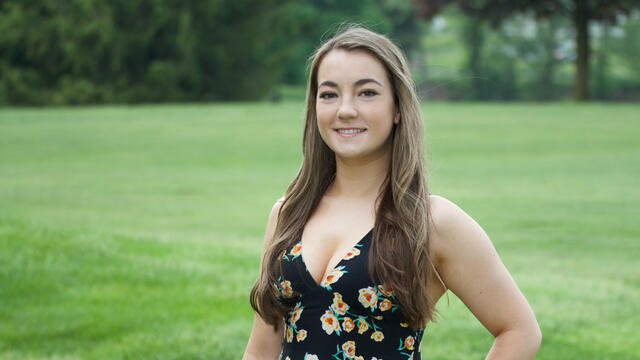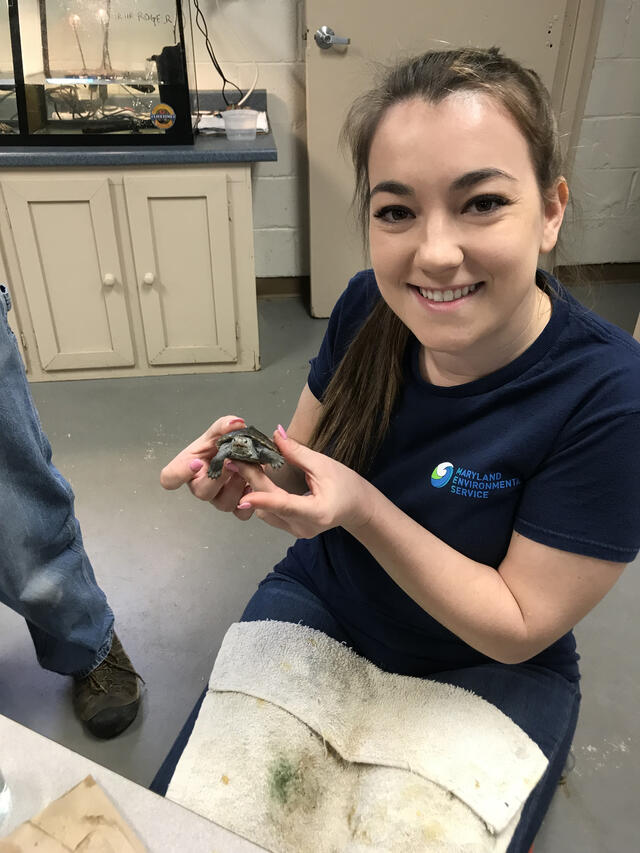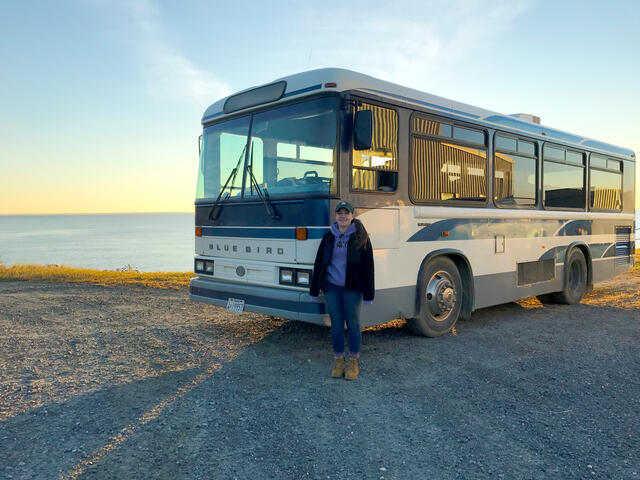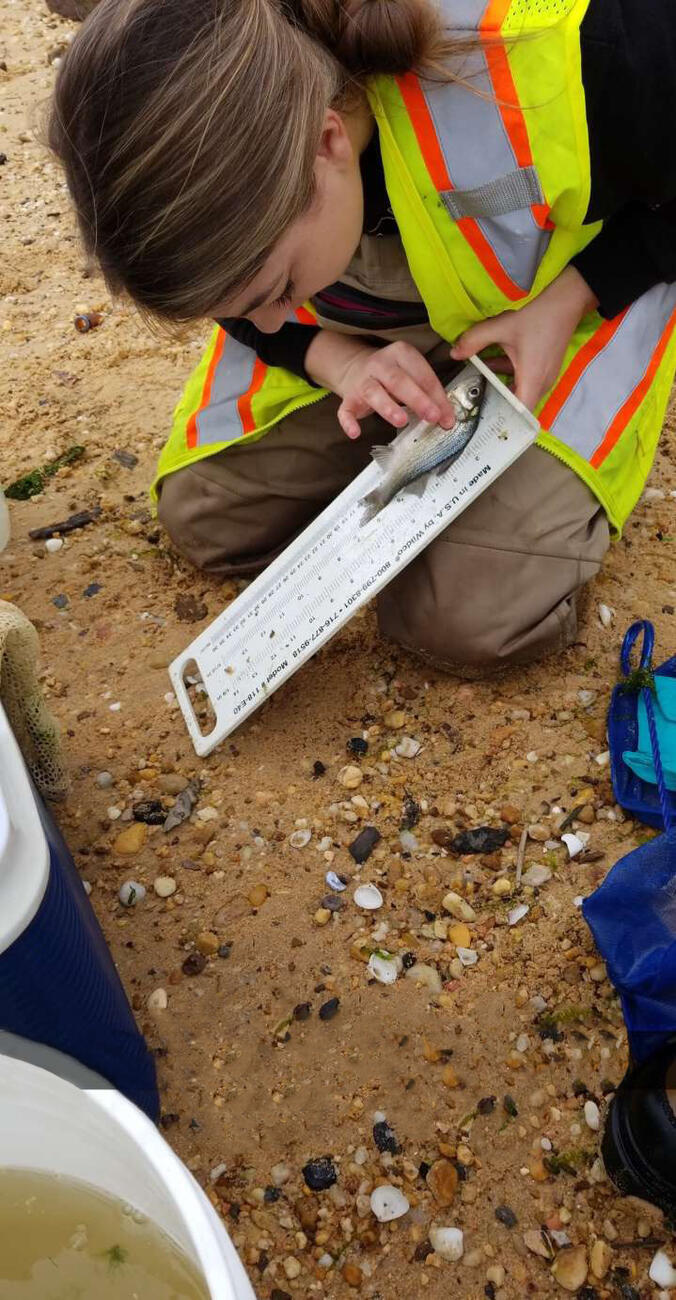Caitlin Eversmier ’18
Caitlin Eversmier ’18 was always interested in art as much she was in science, so finding a liberal arts college like McDaniel where she could pursue a double major was essential. Initially, Eversmier was more focused on her Art major, but she found herself constantly asking questions about environmental impact. Now, she's putting her Environmental Studies and Art dual majors to work on a daily basis at Maryland Environmental Service.

When she was considering colleges, Caitlin Eversmier ’18 was looking for the best of both worlds: “I wanted to continue my love for photography, but I also was really interested in Environmental Studies.”

Eversmier ’18 shows off a Port of Baltimore Terrapin Education and Research Partnership (TERP) head-start terrapin that she tagged after it was hatched on Poplar Island.
As a small liberal arts college, McDaniel was just that place — and provided her internship experiences that would allow her to continue that dual passion in her professional career. Initially, Eversmier was more focused on her Art major, but at her fourth graphic design internship, she found herself constantly asking questions about environmental impact.
“I was working at McCormick and I kept asking, ‘How are we being sustainable? Can we do more environmentally friendly packaging? What are we doing regarding sustainability in the supply chain?’” Eversmier says. “That’s when I figured it out: I love graphic design, but my passion was becoming the environment.”
Once she made that shift in mindset, her career path became a little clearer. Thankfully, that “best of both worlds” experience made her a top candidate in a crowded applicant pool of graduates with Environmental Studies degrees.
In the spring of her senior year, Eversmier was applying for jobs in both of her degrees.
When she applied for an environmental education internship with Maryland Environmental Service, she not only fulfilled the need for an environmental educator but also opened up opportunities for her to provide in-house graphic design support, saving the clients’ money. Combining her two degrees with her four semesters of American Sign Language (ASL) and her involvement in extracurriculars at McDaniel, Eversmier has a variety of skills beyond what she learned in the Environmental Studies department that made her a valuable asset to an employer.
“A lot of people applied to this job. If they’re all environmental majors, what unique benefits could they bring to the company? For me, that was my other degree,” Eversmier says. She was offered the internship the day after her in-person interview; three months later, Maryland Environmental Service created a permanent job for her and she now is a level-one environmental specialist.
Three years in, Eversmier says about a quarter of her job is graphic design, while the rest is environmental field and education work for her client, the Maryland Department of Transportation Maryland Port Administration. It’s the variety that keeps her so satisfied in her work.
“What I love about my job is that I’m not doing the same thing every day,” Eversmier says. “One day, I might be an environmental educator, and I absolutely love working with kids and teaching them about the environment. But I also really love when I’m doing field work. Plus, I still have an outlet for my art when I create flyers for events and educational videos.”

Prior to COVID-19, Eversmier gave driving tours of Hart-Miller Island in Baltimore County. Her tours explained the history of the island's erosion and it's restoration.
One of Maryland Environmental Service’s clients is the Maryland Department of Transportation Maryland Port Administration, who created the Port of Baltimore (TERP) Terrapin Education and Research Partnership. In supporting that client, Eversmier works in conjunction with the National Aquarium in Baltimore, Arlington Echo, and Ohio University. Through this Diamondback Terrapin Head-Start program, they provide students with hands-on learning experiences with Maryland’s state reptile while conducting scientific research on the species.
Whether seining to assess biodiversity at restoration/mitigation sites or raising diamondback terrapins, teaching in classrooms or in the field (where those ASL skills have come in handy more than she expected), Eversmier credits McDaniel for her ability to work on many projects at once.
Her latest project? A master’s degree, which she completed in December 2021. Eversmier contemplated taking a gap year before graduate school, but she was concerned that she wouldn’t be able to get back into the swing of school if she took a break, and she didn’t want to delay gaining professional experience.
“The best option for me was to go to grad school part time and work full time,” Eversmier says. “I ended up picking Johns Hopkins University’s M.S. in Environmental Science, which offers some classes online and some in person. Now, I feel like I am not missing out on building my resume with professional experience while also earning my degree.”
“Something that I really took away from McDaniel was that environmental education is so important. And if people don’t know about an environmental issue, how can they care about it?"
One thing Eversmier has learned both during grad school and in her day job is that she has a real passion for environmental research. “I would love to work for an environmental organization where I can do hands-on research, and maybe continue to provide outreach and education like I do now,” Eversmier says. “But I would really love to stay in the Chesapeake Bay area and do some type of marine research out on the water.”
That doesn’t mean she’s turning her back on her dual degree though: “Something that I really took away from McDaniel was that environmental education is so important. And if people don’t know about an environmental issue, how can they care about it?” Eversmier says. “So, I think I’ll always do something with graphic design; it’s just a great tool to have in my pocket and is a great way to communicate an environmental message to the public.”
About Caitlin
Career: Senior Environmental Specialist
Class: 2018
Major: Environmental Studies with a concentration in Policy and Management and Art with a concentration in Graphic Design
Photo Caption (below): Some of Eversmier’s favorite field work is seining at Cox Creek in Anne Arundel County, where they monitor reef balls by seining around them to evaluate their effectiveness based on the biodiversity they bring up. Here, she measures a striped bass.
